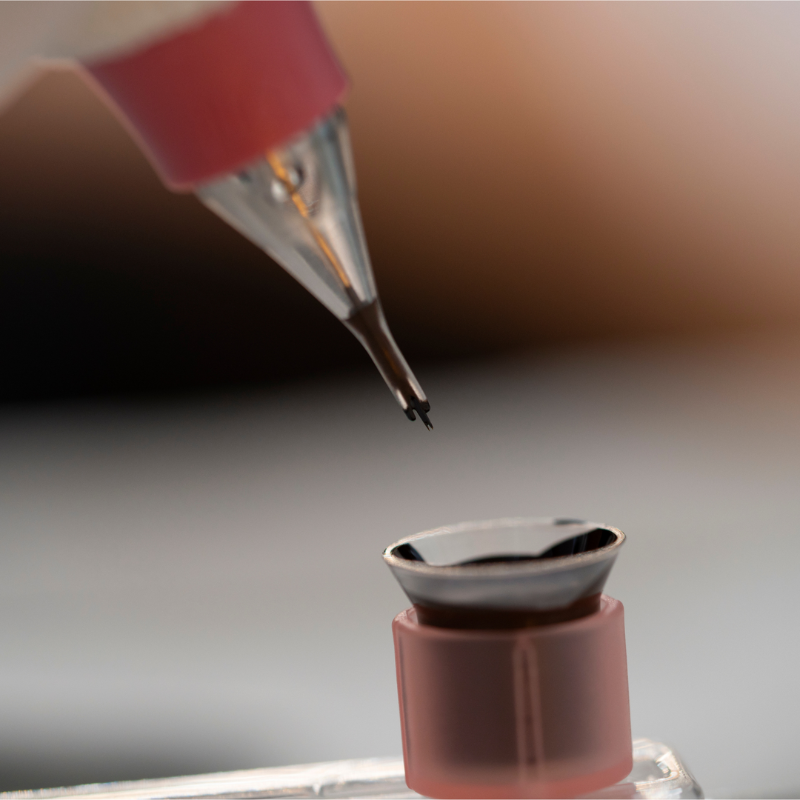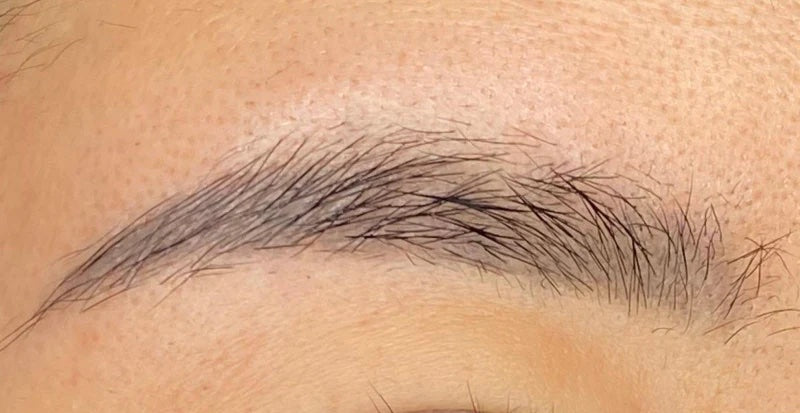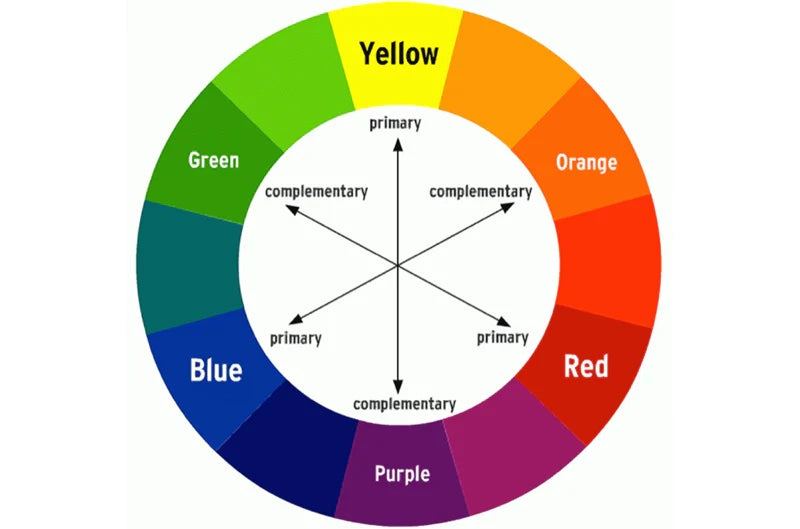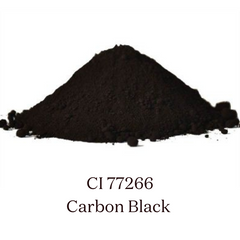Organic vs Inorganic: Understanding Your Brow Pigments
More than ever, artists have the luxury of options when it comes to pigment selection. Although many factors affect which you choose, a major deciding factor is pigment type – organic vs inorganic. This has been a hot topic in our industry, creating a lot of noise and confusion. However, we’re here to set the record straight on organic and inorganic pigments, so that you can better choose between pigments depending on the unique variables presented to you with each client.
In this blog post, we will cover:
1. What are inorganic pigments? What are organic pigments?
2. When to use organic vs. inorganic pigments
3. Maintenance
4. Color Corrections
5. What are hybrid pigments
1. What are inorganic pigments? What are organic pigments?
Do you know why you’re using a specific pigment line? Is it because someone recommended them or because you saw pictures of how they look? Do you know the difference between organic, inorganic, and hybrid pigment lines? Which pigments are a blend of both organic and inorganic pigments?
Organic pigments are made up of carbon rings and chains, while inorganic pigments are derived from natural minerals.
Organic pigments tend to be more vibrant and have a wider range of colors, while inorganic pigments are more muted and earthy.
Organic pigments consist usually of smaller particles, reflect more light, and are more transparent. Inorganic pigments have a larger particle size, reflect less light, and are more opaque.
Organic particles are bright, quick to implant, and long lasting, while inorganic particles are a bit more earthy, may require a few layers to achieve ideal saturation in the skin, and are not quite as long lasting in the skin- which offers more flexibility.
Hybrid formulations are a combination of organic and inorganic particles. We will dive into this topic later on in the blog.
What’s in your pigments? Identifying CI numbers & MSDS sheets
It wasn’t until recently that pigment manufacturers pulled back the curtains behind their manufacturing philosophies and pigment color formulations, so artists could take a deeper dive into what’s in their pigment bottles and how it can affect their work.
There’s more than meets the eye when it comes to pigments. An organic medium brown may look similar in color to an inorganic medium brown, but each is different in its pigment particle composition, which affects the way the pigment behaves in the skin.

You can find the health and safety information, including the pigment particle composition and ingredients in the pigment MSDS (Material Safety Data Sheet). By reviewing the CI (Color Index) codes found in the MSDS sheet or on the label of a pigment bottle, you’ll be able to uncover what actual pigment colors make up your bottle of pigment.
This will help you understand the behavior of organic and inorganic ingredients and how they perform in the skin. Look for CI codes or general color names, such as Yellow 14, Red 254, etc.

Here’s a helpful chart that breaks down the difference between organic and inorganic/iron oxide pigment lines:

Reading pigments

Every pigment formulation contains a unique composition of powdered pigment particles mixed with binding agents and other additives that results in the color that we see straight from the bottle.
Each pigment color has its own name, as well as a 5-digit CI code – e.g. Yellow 138, CI 56300. Often, but not always, they’re listed in order of quantity, descending by weight percentage – meaning the first ingredient listed is the dominant color ingredient.
If the CI code is 76999 and under, the pigment particle is organic.
If the CI code is 77000 and above, the pigment particle is inorganic.

Pigment particle composition table from I ❤️ INK Bolder Brown MSDS
Most pigment formulations on the market today are a hybrid blend of organic and inorganic pigment particles, as both have their beneficial qualities. By reviewing the CI codes of a pigment, you’ll be able to uncover what actual pigment colors make up the pigment, whether it leans more organic or inorganic.* (see section 5. What are hybrid pigments?)
Differences in characteristics
 |
Organic:
|
 |
Inorganic:
|
Powerhouse ingredients

|
|
Titanium Dioxide White (CI 77891) and Carbon Black (CI 77266) are inorganic pigments that are widely used in pigment formulations for their high opacity strength. Titanium Dioxide White lightens the color and is used in color correctors for its excellent ability to cover (think opacity). Conversely, Carbon Black is often used to cool and darken color but is also added to increase the overall longevity of a color.
Although Carbon Black is an inorganic pigment, it has the smallest particle size out of all organic and inorganic pigments, which is why it behaves like an organic pigment. Because of its high lightfastness rating, along with Titanium Dioxide White, they both outlast any other pigments in the skin, leaving behind an ashy/grey residual color and a nude-yellow color, as often seen with organic-based pigment lines. (organic-based means formulation is predominantly made up for organic ingredients)
Because of their composition, it’s important to note these pigments are not entirely interchangeable, but rather there may be circumstances or skin types when it’s best to use organics over inorganics, which we will unravel below.
2. When to use organic vs inorganic pigments

Now that we understand the ingredients, let’s take a deeper dive into how these pigments behave and how to best use an organic vs inorganic pigment.
Every client is unique – from their expectations and desired result, to their skin density, type, and undertone. Along with your experience and working technique, these factors play a role in whether you should use an organic or inorganic pigment.
The basic guidelines are: organic-based pigment lines such as Perma Blend, including Tina Davies I LOVE INK, will deposit into the skin easier and stay around much longer with little to no fading. They are less forgiving and almost “forever” lasting since the small particle sizes implant easier. Therefore, it is imperative that you DO NOT OVERSATURATE when working with organic-based pigments to give yourself room to add more color definition in the future if needed.
Inorganic-based pigment lines have larger particle sizes and take longer to deposit into the skin than an organic-based pigment. (inorganic-based means formulation is predominantly made up for inorganic ingredients) As a result, they are more forgiving and will fade at a faster rate. Therefore, these pigments are great for newer artists, or for clients who want less commitment to color, shape, and permanency.
Continue reading to learn more about the differences between organic and inorganic pigments.
The nature of organic pigments

Organic pigments are vibrant in color and last a long time in the skin. For clients, this means less long-term maintenance, as fewer touch-ups are required. However, this also means that clients must commit to both color and shape from the very beginning, with little room for adjustments over time due to the permanency of the organic particles.
When using organic pigments, the goal is to not oversaturate, as these pigments are “less forgiving”. Regardless if your client wants soft and natural brows or defined and bold brows, it’s best to stay conservative with saturation and evaluate upon healing. Focus on giving the brows an “airy” look, ideally with skin showing to create negative space and dimension. Good ways to control pigment saturation are through techniques such as layering and pigment diluting (shading solution), to build color without dense saturation. The look of brows should resemble powder, not solid ink.

“Airy” brows immediately after
Photo courtesy of The Perfect Brow course by @elainecampinelitebrows
For newer artists, the proper working technique is crucial when using organic pigments, especially on clients with thinner skin. Pay attention to your needle angle, depth, hand speed, and pressure, making sure to remain consistent throughout the procedure. Use a light hand and stop tattooing when you reach a “powdery” saturation level. Going too deep will result in the pigment “blowing out”, and appearing ashy/dark beneath the skin, which the result may last indefinitely.
The nature of inorganic pigments
Inorganic pigments are earthy and muted in color, which generally makes for natural, subtle results. They’re less permanent compared to organic pigments, as they often fade out of the skin within a couple of years. Inorganic pigments provide ultimate flexibility for clients who want less commitment to color, shape, and permanency. However, these pigments will require more frequent touch-ups – a great opportunity to adjust the shape and color of your client’s brows as they age.



Inorganic pigments are made up of larger particles, meaning these pigments do not enter the skin as easily as organic pigments. This means an adjustment to hand pressure (slightly heavier) and more passes may be required to reach ideal saturation. Since these pigments are a bit trickier to implant, you can also expect to see a greater loss in saturation upon healing compared to organic pigments. This makes inorganic pigments “more forgiving” and better fitting for newer artists. The proper working technique is still required, as going too deep will still inevitably cause ashy/dark results.
PRO Tip: For inorganic pigments, you can use a larger needle configuration (e.g. 3RL/RS, 5RS, or even a 7CM) over a single round liner to help with faster saturation, especially on clients with thicker skin.
When to use organic or inorganic
However, there may also be cases when your client may be better suited for inorganic-based pigments, such as clients who will pull dark and cool – like those with mature, thin skin, fair-skinned clients with dark hair, or clients who have visible sun damage.
You may also find that you have young clients who want a bold, trendy style brow with a lot of saturation. If we used an organic pigment on them, there would be no room for adjustment in color or shape as they age when this style no longer suits them, so you may want to reach for your inorganic-based pigments.
Inorganic-based pigments may also be advantageous for newer artists, as they tend to be more flexible and forgiving, giving you – the artist – more ability to make adjustments over time. This flexibility is ideal for artists and clients who aren’t ready to commit to a specific lifelong shape or color. It also allows you as an artist to ensure a long-term relationship with your clients, as you can expect to see them annually.
To summarize, when working with organic pigments, don't oversaturate and aim for a “soft and airy” deposit. Stop tattooing when you see the intended outcome that resembles a healed result. When working with inorganic pigments, you will need to apply more layers to saturate and more treatments to reach optimal saturation.


3. Maintenance

The rates at which organic and inorganic pigments fade out of the skin are different. Based on your client’s goal and the type of result and longevity that you see fit to deliver, you’ll need to choose your pigments accordingly so that you can meet their expectations, on a realistic level – this means informing your client during their consultation. Your maintenance policy and variables of your client’s skin, including previous PMU, overall health, skincare routines, and environmental exposures also come into play.
Once you understand the basic principle of saturation, you'll be confident in providing your clients with brows that will suit their needs and meet their expectations. With a proper maintenance protocol, you can be their trusted artist to keep them looking fantastic for life, not to mention built-in loyalty that will provide you with recurring revenue for years to come.
During consultation it’s important to explain to your client that their brows will need to be maintained for optimal beauty down the road, just like other beauty services such as hair or nails. The color will start to fade and the shape may require updating.
Be sure to book this appointment before your client leaves your office and offer an incentive if needed to get it secured. This also reinforces your professionalism and dedication to client care.
Here’s a helpful chart that breaks down the WHAT, WHEN, and HOW of PMU brow maintenance:

Timing & touch-ups
As we’ve learned with organic-based pigments, they implant easily into the skin. Sometimes a touch-up after the initial treatment isn’t even necessary. With these pigments lasting a very long time, clients can often go 2-3 years before needing a touch-up.
On the other hand, since inorganic-based pigments have a lower level of saturation in the skin, a touch-up will likely be needed after the initial treatment to achieve ideal saturation. As inorganic pigments are less permanent, you should plan to see your clients for annual touch-ups on a routine basis, ideally between 12-24 months.
What to expect with fading

Brows done with organic-based pigments are extremely long-lasting but tend to “dull” and look cooler over time due to the presence of Carbon Black and Titanium Dioxide White as other pigments (red, yellow) fade from the skin. They require a warm (orange or yellow-based pigment) color boost to bring back warmth to the area. This will brighten and warm the brows without making them darker and more saturated. A common mistake is using a dark, cool pigment without a warm undertone – this can lead to more coolness down the road.

Photo courtesy of Ombré Brows Online by @beauteacademystudio
Brows done with inorganic pigments can fade by 50-70% and leave behind a residual undertone of red/orange as Iron Oxide Black breaks down, or cool/ash if Carbon Black is present. For a red/orange residual undertone, you can neutralize the color using a green-olive pigment before proceeding with the target color of your choice.
It’s best to let your client know what to expect for general maintenance and touch-up, so they are aware of what to expect during the months and years to come.
Residual Colors
Brows done with organic-based pigments may have a residual undertone of cool/ash due to the presence of Carbon Black and Titanium Dioxide White. Brows done with inorganic/iron oxide pigments can have a residual undertone of either red/orange or cool/ash as the Iron Oxide Black breaks down, leaving behind other residual colors.
What type of pigment to use
Brows done with organic-based pigments will require the use of organic-based pigments again for staying power and coverage. Brows done with inorganic/iron oxide pigments can be redone with organic-based or inorganic/iron oxide-based pigments again, depending on the client's goal. At this point, the client may want to continue with inorganic/iron oxide pigments for more flexibility and fading or move to organic-based pigments for more longevity.
What to do if the brows are too saturated
When the brows are too saturated, dense, or flat, the best approach is either laser tattoo removal or saline removal as the current state of the tattoo is too prominent and the design cannot be improved without the removal of some or all of the current eyebrow tattoo. Most clients do not want to go down this route, but it’s often the best approach for the best long-term results. As long as the pigment is lifted by approximately 50%, it will look so much better already and may be enough to work from! Getting to this level may require a few sessions of laser or saline removal.
4. Corrections
In the world of PMU, you will come across cases of faded red, orange, purple, magenta, grey, blue, and green eyebrows. What you’re seeing are the previous pigment colors degrading in the skin at uneven rates. To be a well-rounded artist, you will need to learn how to correct these issues.
Color corrections are only effective on brows that have faded by at least 50%. A light shadow is ideal. The skin can only hold so much pigment before it stops taking pigment. If the brows are too saturated or they’re an ashy/dark color due to the previous work being too deep, removal is required.
For best results, brows done with organic-based pigments will require “warming up” with warm-based organic-based pigments (think orange, yellow, or reds with a yellow base) again as this will have the maximum effect and staying power to combat the grey/ash undertone. Brows done with inorganic/iron oxide pigments will have a residual undertone of cool/ash or red/orange and can be redone again with organic-based or inorganic/iron oxide pigments depending on the client’s goal.
Levels of saturation

70% faded – ideal for correction
Photo courtesy of Ombré Brows Online by @beauteacademystudio

5-10% faded – overly saturated – removal required
If your client's brows are at least 50% faded, you will need to identify what pigment is best-suited to color correct. Start by identifying the residual color left on their skin, by using the
- You can color correct old tattoos that have turned blue, purple, or red by understanding complementary colors
- For example, to correct blue brows, you first have to identify the complementary color of blue
- As you can see from the color wheel, orange can offset the blue. On the contrary, if you are trying to correct red brows, you need green to offset the red

Photo courtesy of Ombré Brows Online by @beauteacademystudio
To color correct previously tattooed brows, you need to ask yourself the following questions:
What color is the old tattoo?
Identify if the old tattoo is blue/grey OR red/orange.
What is the complementary color of the old tattoo?
If the old tattoo is blue/grey, orange is the complementary color.
If the old tattoo is red/orange, green is the complementary color.
What is the target color?
The target color is the final end color you desire.
If the old tattoo is cool and ashy, your target color/pigment should contain a warm undertone.
If the old tattoo is red and warm, your target color/pigment should contain a cool undertone.
5. What are hybrid pigments?
Now that you have understood organic vs inorganic, here is a breakdown of how hybrid pigments work.

All Perma Blend pigments, including Tina Davies I ❤️INK, are a blend of both organic and inorganic pigments and are identified as a hybrid pigment line.
Hybrid pigment formulations have a blend of both organic and inorganic pigment particles. By combining both pigment types, we are able to take the benefits of each - for optimized color brightness, opacity, and ideal longevity.
This means that any blend of organic & inorganic pigments is considered hybrid, however, not all hybrid pigments are created equally. There is a whole spectrum of hybrid pigments. Some may be organic-based (like I ❤️INK), meaning they contain more organic pigment particles than inorganic pigment particles, while others may be inorganic-based, meaning they contain more inorganic pigment particles than organic pigment particles (like FADE Eyebrow Pigments).

IMPORTANT REMINDERS
In any PMU procedure, knowing the type of pigment line you are using and how to use it based on the way it behaves is a CRITICAL part of creating beautiful outcomes for your clients for years to come.
You will need to consider all the listed factors, and your service promise, to optimize what is best for you and your clients. For example, if you want to offer more flexibility coupled with less commitment and more maintenance, you may opt for inorganic pigments. If you want to offer more permanency/commitment coupled with less maintenance, you may opt for organic-based pigments.
It will take you about 2-3 touch-up cycles to get to know how different these two types of pigments perform over time in order to apply your learnings to suit your business and each client’s needs.
With a greater understanding of organic and inorganic pigments, you can better choose between pigments based on each client’s individual scenario. One is no better than the other – it’s best to have both organic and inorganic pigments handy.
1 comment
This is such a great article! I’ve already shared with several of my students! It provides such a great explanation of when to use organic vs inorganic pigments and how they react in the skin
@browmentormelissa




